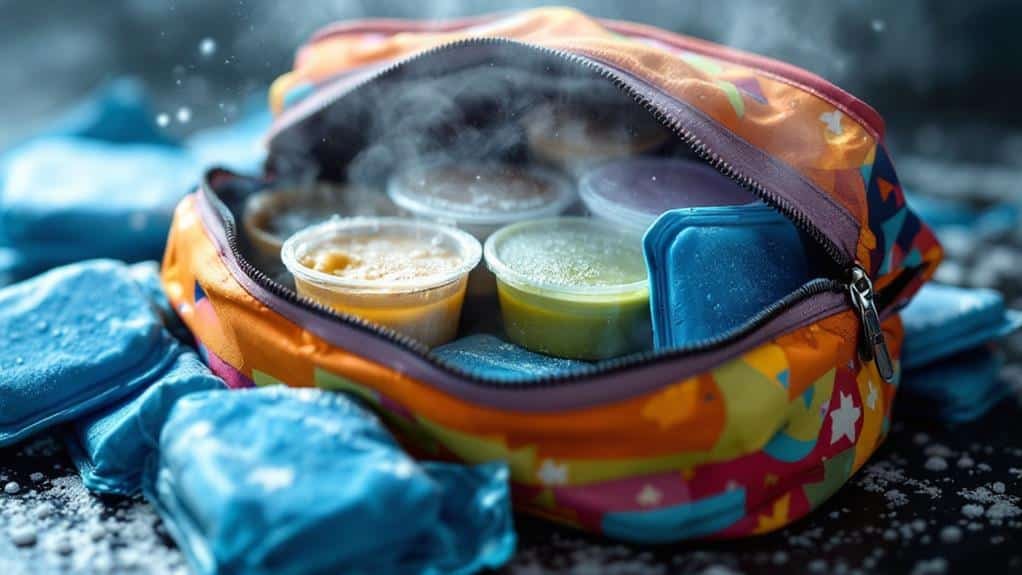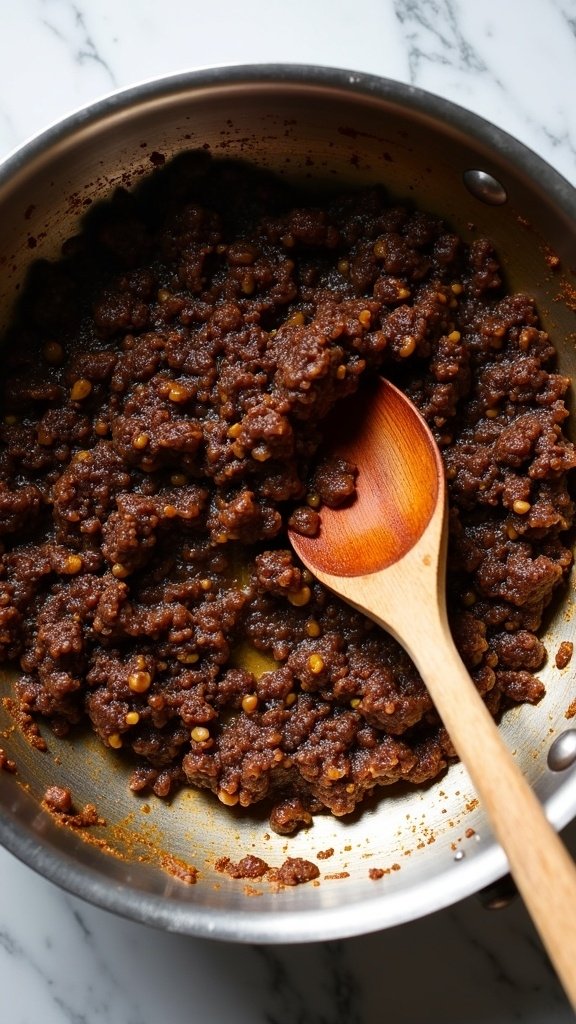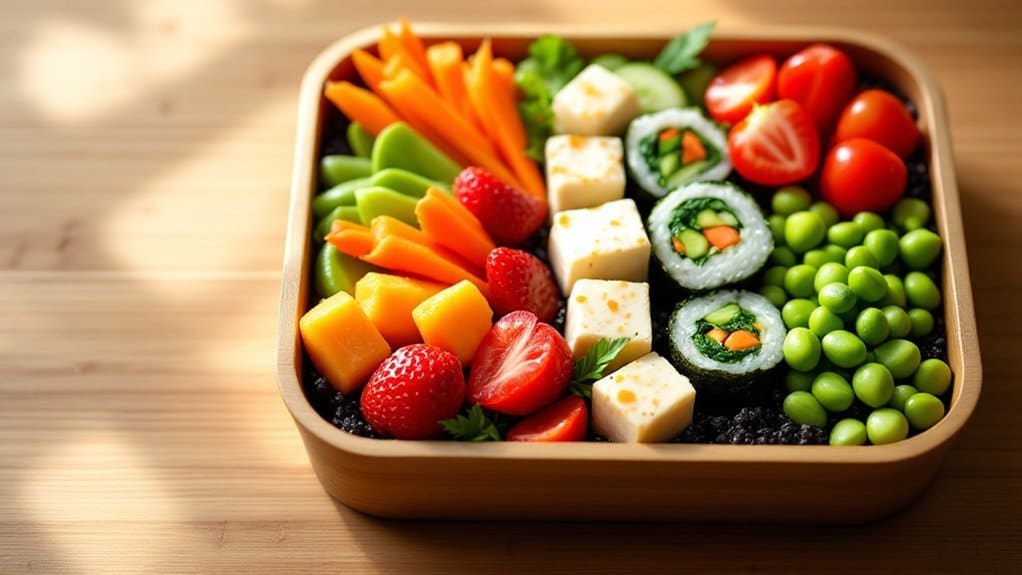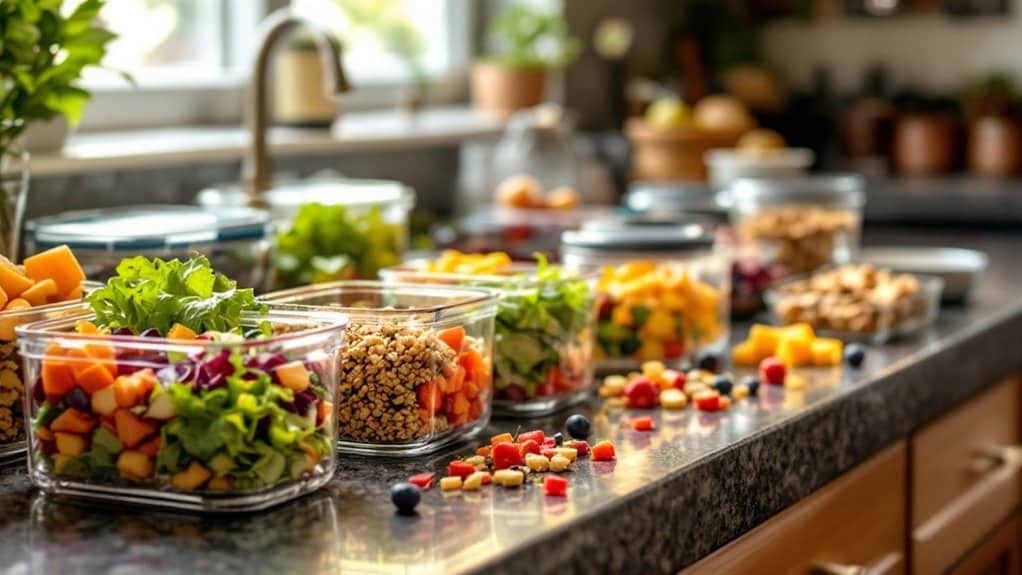Let’s make sandwich prep both safe and efficient in your kitchen. When using mandolines and sharp knives, we always start with proper safety equipment – a well-fitted cut-resistant glove and handguard are non-negotiable. We’ll keep our workspace clean and organized, using non-slip cutting boards and maintaining a steady, controlled grip during slicing. For consistent results, we slice firm vegetables like cucumbers and carrots at 1/8 inch thickness, avoiding soft produce that might tear. Remember, rushing through prep isn’t worth a trip to the ER. There’s much more to explore about mastering safe sandwich techniques in your kitchen.
Key Highlights
- Always wear cut-resistant gloves and use hand guards when operating sharp tools like mandolines or knives during sandwich preparation.
- Maintain a clean, organized workspace with non-slip cutting boards to prevent accidents while handling multiple sandwich ingredients.
- Use smooth, controlled motions when slicing ingredients, and never rush, even when preparing multiple sandwiches.
- Keep knives sharp, and mandoline blades well-maintained, as dull blades require more force and increase injury risk.
- Focus entirely on prep work without distractions, and keep a first aid kit nearby for immediate response to cuts.
Essential Mandoline Safety Equipment
When using a mandoline slicer, you’ll need two critical pieces of safety equipment: a cut-resistant glove and a hand guard. We’ve learned this lesson the hard way – trust us, those blades don’t discriminate between veggies and fingers!
Different mandoline types have varying safety features, but we never rely on those alone. Even with the fanciest models, we always double up on protection. The hand guard that comes with your mandoline is your first line of defense, keeping your fingers away from the blade while securing your food.
But here’s where we get serious – a cut-resistant glove is non-negotiable. We’ve seen too many home cooks skip this step, thinking they’re careful enough. That’s like riding a motorcycle without a helmet because you’re “really good at balancing.”
The glove should fit snugly but not restrict movement. We recommend getting one that’s machine washable since you’ll be using it often. Remember, even professional chefs wear these – it’s not about skill level, it’s about smart preparation.
Safety equipment might seem like overkill until the one time it isn’t.
Proper Grip and Slicing Techniques
A firm, controlled grip transforms the mandoline from a risky tool into a precise slicing instrument. Let’s master the proper technique to boost your slicing efficiency while securely attaching all fingers.
First, position yourself with a straight back and relaxed shoulders. We’ve learned the hard way that tension leads to accidents! Your dominant hand should grip the food holder firmly, with your thumb and fingers wrapped securely around its handle.
Keep your wrist straight and aligned with your forearm for maximum grip stability. Think of your arm as one solid unit moving smoothly across the blade. We want controlled, rhythmic movements – not erratic sawing motions that’ll send cucumbers flying across the kitchen.
Remember to use the entire length of the mandoline’s surface. Start at the top and glide downward with consistent pressure. There’s no need to rush – we aim for uniform slices, not a speed record.
When you’re down to the last inch of vegetable, that’s your cue to switch to the hand guard. Trust us, those final slices aren’t worth a trip to the emergency room!
Cleaning Your Mandoline Between Uses
A proper cleaning routine after each mandoline use prevents cross-contamination and extends the lifespan of your tool. We’ve all been tempted to give our mandoline a quick rinse and call it a day, but trust us – taking those extra few minutes for thorough cleaning will keep you slicing safely for years.
Let’s start with sanitizing surfaces right after use. We’ll want to carefully disassemble the mandoline, being mindful of those razor-sharp edges. Warm, soapy water is your best friend here – it breaks down food residue while maintaining blade hygiene. Don’t forget those little grooves and corners where food particles love to hide!
Never soak your mandoline completely underwater, which can damage the adjustment mechanisms. Instead, use a cleaning brush with sturdy bristles to get into tight spaces. You know that satisfying feeling when you hear the bristles scrubbing away? That’s the sound of proper cleaning!
For stubborn bits, a mixture of baking soda and water creates a gentle paste that won’t scratch the surfaces. Once clean, dry thoroughly with a clean cloth and store in a dry place.
Best Vegetables for Mandoline Slicing
Now that your mandoline is spotless and ready for action let’s explore which vegetables work best with this versatile tool. We’ve found that firm vegetables deliver the most consistent results and let you master those best slicing techniques without frustration.
Root vegetables and sturdy produce are your mandoline’s best friends. When we’re prepping sandwiches, these vegetables consistently give us perfect, uniform slices to make your creation look like it came from a professional kitchen.
| Vegetable | Thickness | Best Uses |
|---|---|---|
| Cucumbers | Paper-thin | Fresh subs |
| Radishes | 1/8 inch | Garnishes |
| Carrots | 1/16 inch | Asian slaw |
Following our vegetable preparation tips, always start with fresh, crisp produce thoroughly washed and dried. We’ve learned slightly chilled vegetables tend to slice more cleanly than room-temperature ones.
Avoid soft tomatoes or delicate leafy greens – they’ll turn to mush. Trust us, we’ve made that mistake before! Instead, stick to potatoes, beets, onions, and other firm vegetables that’ll hold their shape and make your sandwich prep a breeze.
The quick stir-frying technique preserves nutrients and natural crunchiness in vegetables when preparing hot sandwich fillings.
Storage and Blade Maintenance
Proper storage and maintenance transform your mandoline from a short-lived tool into a lasting kitchen companion. We’ve learned that keeping our mandoline’s blade sharp and rust-free isn’t just about longevity – it’s about safety, too. When blades get dull, we tend to use more force, which increases our risk of accidents.
After each use, we’ll want to hand wash our mandoline immediately and dry it thoroughly. Avoid the dishwasher, as harsh detergents and heat damage the blade’s edge. We recommend transferring your sliced ingredients to airtight containers for food storage rather than leaving them on the mandoline’s surface.
When it comes to blade sharpening, we’ve got options. Most mandolines have replaceable blades, which is often the safest choice. If you’re comfortable with blade maintenance, a professional sharpening service can restore your blade’s edge. Just remember – attempting to sharpen mandoline blades yourself can be risky business.
Store your mandoline in a dry place, preferably in its original container or a protective sleeve. We keep ours in a dedicated drawer, blade-side down, away from other utensils that might damage it. Using a non-porous surface like plastic for food prep helps prevent bacterial growth and makes cleanup significantly easier.
Common Mandoline Safety Mistakes
Safe storage habits protect us from accidents, but even careful cooks make mistakes while using mandolines. Let’s debunk some common mandoline myths and learn from real user testimonials about what not to do with these razor-sharp tools.
We’ve all heard someone say, “I don’t need the hand guard – I’m careful!” Trust us, that’s the number one mistake that leads to emergency room visits. Your fingertips aren’t worth the risk of getting those last few perfect slices.
Another dangerous habit is trying to clean the blade while it’s still attached to the mandoline. It is understood that it’s tempting to rinse it off quickly but always disassemble the tool first. Those blades are just as sharp when they’re wet!
Don’t fall for the myth that dull blades are safer. They’re more dangerous because you’ll need to apply more pressure, increasing the risk of slipping. Keep those blades sharp and respected.
Full attention means all fingers stay attached!
Consider using digital kitchen scales for precise measurements when slicing ingredients to ensure consistent, even cuts throughout your preparation.
Speed Versus Safety Trade-offs
Rushing through food prep might save a few minutes, but those precious moments aren’t worth risking your safety in the kitchen. We’ve all been there – trying to whip up lunch in record time while juggling other tasks. But here’s the truth: speed considerations should never override proper safety protocols.
When making sandwiches, skipping those seemingly tedious safety enhancements like using cutting boards with non-slip mats or taking time to position our hands while slicing properly is tempting. Trust us, we’ve learned that those extra 30 seconds can prevent hours in the emergency room.
Let’s break this down practically. If you’re in a hurry, opt for pre-sliced ingredients or prep components in advance during less rushed times. We can still maintain efficiency without compromising safety by organizing our workspace strategically.
Remember the old saying: measure twice, cut once? We like to say, “slice slowly, sandwich safely.” It might not be as catchy, but it’ll keep all your fingers intact for tomorrow’s lunch prep! Taking just 20-minute breaks while preparing meals can help maintain focus and prevent accidents in the kitchen.
Emergency Response for Cuts
Despite our best safety precautions, accidents can still happen in the kitchen. When working with sharp knives during sandwich prep, it’s essential to know precisely how to respond to cuts and injuries.
Let’s review our vital first-aid response steps for kitchen cuts:
| Severity Level | What to Do | What to Avoid | When to Seek Help |
|---|---|---|---|
| Minor Nick | Clean with soap, apply pressure | Using dirty cloth | If won’t stop bleeding |
| Small Cut | Rinse, bandage, elevate | Kitchen work | If deep or gaping |
| Deep Cut | Direct pressure, clean dressing | Moving around | Immediate medical care |
| Severe Wound | Call 911, apply pressure | Removing pressure | Always get help |
We’ve learned through injury prevention training that the first few minutes after a cut are significant. Keep a well-stocked first aid kit within arm’s reach of your prep area – you’ll thank yourself later.
Remember: no sandwich is worth a trip to the emergency room. If you’re feeling dizzy, rushed, or distracted, taking a break is better than risking a serious injury. We’ll always have time to make another sandwich!
To Sum it Up
We’ve covered all the essentials of mandoline safety to help you slice confidently. Remember, rushing through prep isn’t worth a trip to urgent care – we’ve all learned that lesson the hard way! By following these safety guidelines and properly maintaining your tools, you’ll create perfectly uniform sandwich ingredients in no time. Stay safe, take your time, and enjoy the satisfying results of precise, professional-looking cuts.









